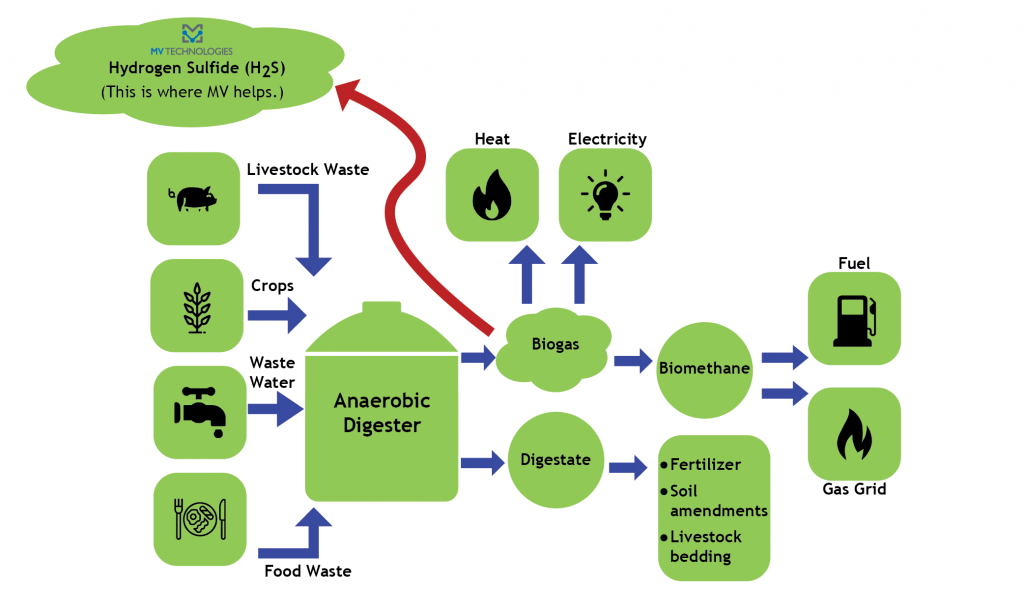Updated: November 2025
Turning Organic Waste into Opportunity: The New Case for Anaerobic Digestion
Anaerobic digestion has long been celebrated for its environmental and economic benefits – from diverting organic waste to generating renewable energy. But the landscape of anaerobic digestion is rapidly evolving. With new technology, policy incentives, and market demand, the benefits of anaerobic digestion have never been more compelling. At MV Technologies, we’re closely tracking these changes – and helping our clients capture even more value from their biogas systems.
Anaerobic Digestion
MV Technologies H2SPlus ™ and SulfAx ™ Systems are in use to treat H2S in biogas streams for emissions control to beneficial end-use across applications from anaerobic digesters at farms, wastewater treatment facilities, food and beverage processing and more. Our systems have been used in treating anaerobic digestion biogas (methane) used in boilers, internal combustion engines, gas turbines and gas-upgrading (RNG) facilities.
MV has been involved in and successfully completed over 40 municipal, industrial and private anaerobic digestion (AD) projects. In addition, we are integrated into the first municipal waste dry digestion facility in North America.
For many readers, the benefits of anaerobic digestion may already be familiar, but for those who are new to the concept, it is essential to understand its economic and environmental significance. By harnessing biogas for energy production, businesses and municipalities can reduce their reliance on fossil fuels, lower energy costs, and contribute to a circular economy in which waste is transformed into new products. Here’s a deeper dive into what anaerobic digestion is – its primary benefits.
What Is Anaerobic Digestion?
Anaerobic digestion is a naturally occurring process. In the absence of oxygen, bacteria break down organic materials and produce biogas. The process reduces–or digests–the amount of organic matter, producing biogas as a byproduct. This biogas can then be used as an energy source. Anaerobic digestion (AD) technology is commonly used throughout the United States to break down sewage sludge at wastewater treatment facilities, byproducts at food and beverage processing facilities and waste (mainly manure) at farms.

The Benefits of Anaerobic Digestion
Environmental Benefits of Anaerobic Digestion
One of the most obvious environmental benefits of anaerobic digestion is its function in reducing greenhouse gas emissions. By capturing methane gas that may have otherwise been lost to the atmosphere, anaerobic digestion operations displace fossil fuel energy use. This contributes to climate change mitigation and is notably beneficial in all waste management technology use scenarios.
The use of anaerobic digestion technology on farms provides a multitude of examples of how anaerobic digestion benefits the environment. As farmers work diligently to meet the increasing demand for food and remain viable and profitable in the current global market place, the efficient use of manure and nutrients for crop and livestock needs can reduce costs and environmental impacts and contribute to safer, more productive farms.
Digesters on farms can:
- Protect animal and human health by reducing pathogens.
- Convert nutrients in waste into more accessible forms for plants to use compared to raw manure, thereby increasing crop productivity and yield.
- Recycle nutrients on the farm, creating an economically and environmentally sustainable food production system.
- Produce heat, electricity, or fuel from biogas (methane gas) which can be used onsite, lessening the agriculture sector’s dependence on fossil fuel energy.
- Accept food waste from places like restaurants and grocery stores. This means less food waste is sent to landfills. Food waste has the added benefit of increasing the efficiency of farm digesters.
Environmental & Circular-Economy Benefits Are Growing
According to the EPA, anaerobic digestion continues to deliver strong environmental impacts: it reduces methane emissions, diverts organic waste, and produces nutrient-rich digestate that can enhance soil health. epa.gov
Meanwhile, a global review of AD’s role in the circular economy highlights its importance in achieving “dual carbon” goals — reducing both carbon emissions and reliance on linear waste management. MDPI
Sustainability Frameworks & Policy Support Are Aligning
Countries and companies are increasingly adopting anaerobic digestion as a core component of their circular economy strategies. From municipal wastewater plants to co-digestion facilities, AD is being deployed not only to generate energy, but also to recover nutrients and reduce waste — all in service of climate and sustainability goals.
Incentives, carbon markets, and RNG credit programs are now aligning to make anaerobic digestion more attractive — especially for projects with strong gas upgrading capabilities (like those supported by MV Technologies).
Economic Benefits of Anaerobic Digestion
Aside from numerous environmental benefits, there are several economic benefits associated with utilizing anaerobic digestion technologies. For wastewater treatment or sewage facilities that are incorporating food waste into anaerobic digesters, they experience two-fold savings through the reduction of energy costs via onsite power production, as well as through the receipt of tipping fees for accepting the food waste from food processing companies. Food and beverage processing facilities can leverage the same benefits on site, but the introduction of food waste into wastewater treatment facilities has become increasingly popular in recent years.
The construction and operation of digesters creates local job opportunities and increases local tax revenue, presenting opportunities in several forms. Digesters create opportunities for:
- Local contractors specializing in site work, concrete, plumbing, electrical, permitting and engineering during the planning and construction phase of the operations.
- Skilled laborers to keep the system functioning at optimal levels once completed and operations.
- Businesses specializing in nutrients, manure solids and energy markets.
- Agro-tourism; whereby visits to farms allow guests to learn about environmental improvements and the source of their food.
Stronger Economics via Carbon Payments and RNG Incentives
Anaerobic digestion technologies not only create valuable opportunities for waste management and energy production but also offer a compelling secondary revenue stream through the sale of organic nutrients derived from the by-products of digested waste. This process involves breaking down organic material in the absence of oxygen, resulting in biogas (or methane)—a renewable energy source—and digestate, which is rich in nutrients.
The digestate, a nutrient-rich by-product, can be further processed and marketed as organic fertilizer or soil amendment, making it an attractive option for agricultural and horticultural sectors seeking sustainable growth solutions.
For all industries utilizing anaerobic digestion technologies, the opportunity to reduce energy costs is present due to the utilization of biogas to generate electricity and fuel on-site vehicles; thereby reducing dependence on local utilities.
However, anaerobic digestion operations also provide an additional revenue stream with the option to sell excess methane gas or the electricity generated by the biogas to the local utilities, providing locally sourced renewable energy to the respective community and tax credits, RINS and LCFS to the processing source.
A recent report from Iowa State University highlights how carbon payments could be a game changer for farmers deploying digesters. While energy prices alone offer some return, their analysis shows that carbon credits can significantly boost project viability, especially for RNG (renewable natural gas) production.
This isn’t just theoretical: by monetizing methane reductions, farms and digesters can unlock a key revenue stream — accelerating payback and improving long-term profitability.
RNG Market Growth & Upgrading Technologies
Anaerobic digesters are increasingly integrated with biogas upgrading systems as the shift toward biomethane (RNG) accelerates. The latest American Gas Foundation study (2025) underscores this trend, noting that co-digestion strategies (e.g., mixing manure with food waste) and advanced gas conditioning are helping drive more efficient, scalable RNG projects.
These innovations mean AD is no longer just about on-site power — it’s about producing high-purity gas that meets pipeline specifications.
Leverage Your AD Benefits With MV Technologies
For those looking to maximize the benefits of anaerobic digestion, consulting with industry professionals can provide invaluable insights and solutions tailored to specific organizational needs. Engaging with experts can help identify potential weaknesses in existing anaerobic digestion management setups, implement best practices, and deploy advanced technologies that enhance overall performance.
Why MV Technologies Is More Relevant Than Ever
With the evolving AD landscape, MV Technologies’ expertise is particularly well-suited to support high-value, modern projects:
- Our H₂SPlus™ and SulfAx™ media systems are designed to integrate with high-pressure or co-digestion digesters, protecting downstream infrastructure.
- Efficient removal systems (MVNets™) ensure your tanks are not offline, and that media is simply lifted from the tops of tanks.
- Our modular and scalable designs make it easy for facilities to expand or upgrade as they adopt new AD technologies or increase biogas throughput.
Whether it’s through effective monitoring, strategic planning, or systems implementation, a partnership with specialists can lead to significant improvements. Contact us today to discuss how we can help leverage your organic matter anaerobic digestion benefits.

